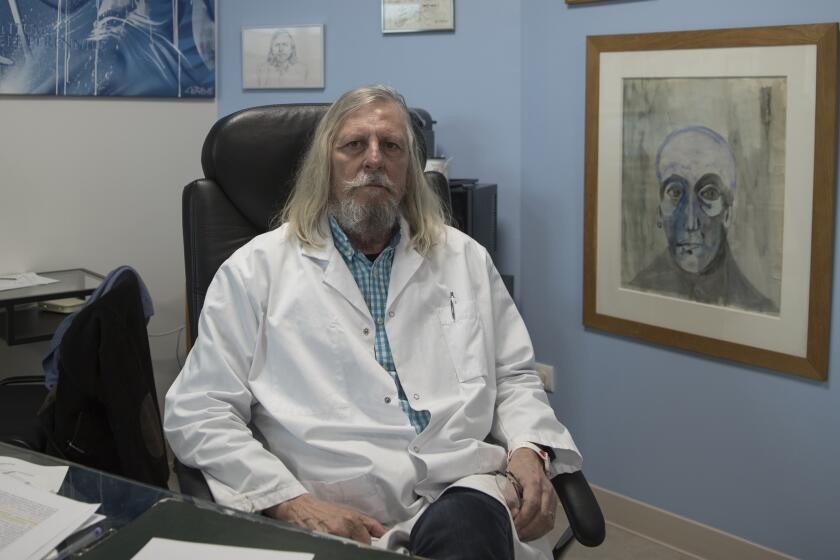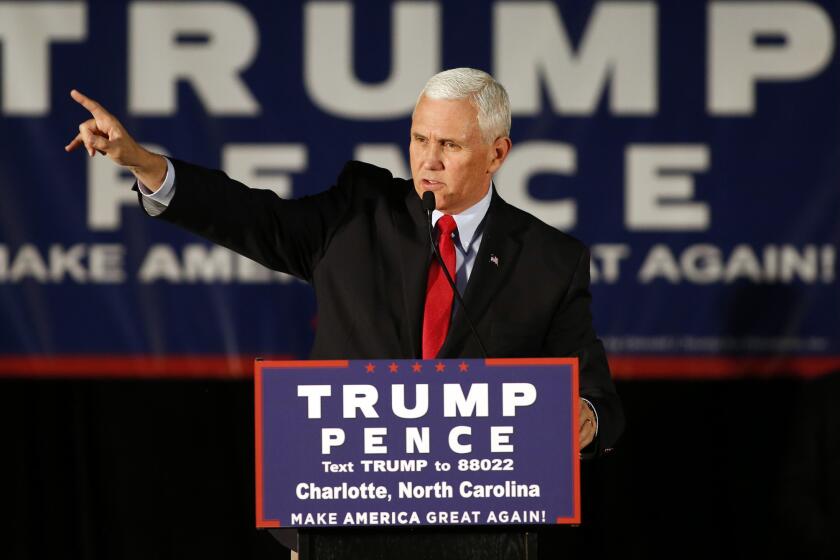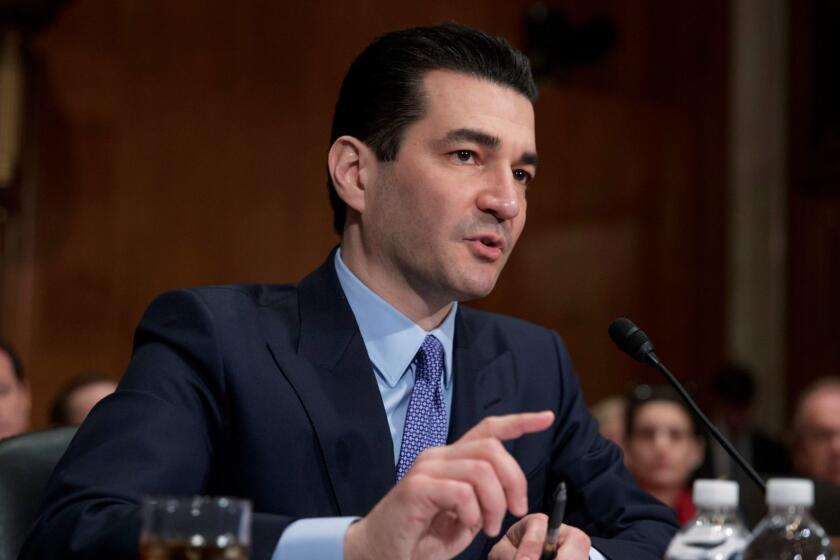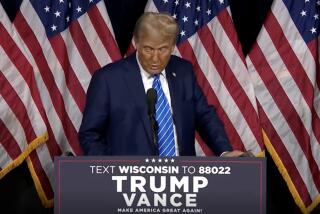Column: Thanks to Trump, the FDA just had the worst day in its history
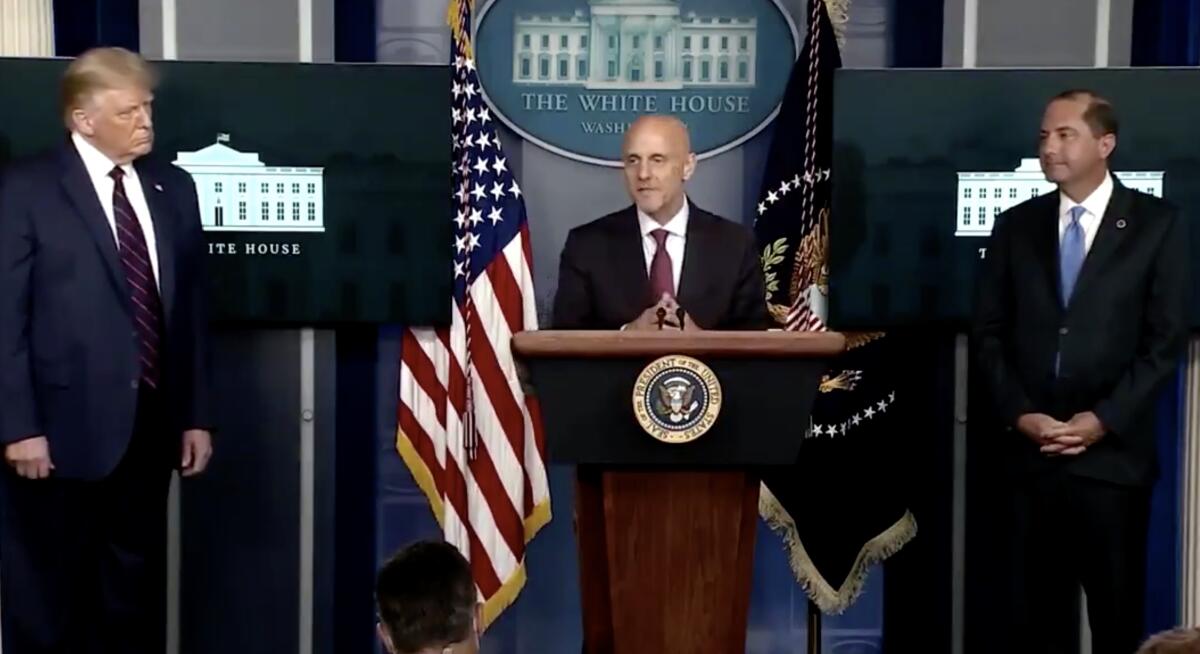
The Food and Drug Administration long has served as the nation’s bulwark against unsafe and ineffective drugs.
The agency earned the nation’s confidence and its reputation by standing up for public health.
That reputation derives in part from the courage of officials such as Frances Kelsey, who in 1960 refused to allow the morning sickness drug thalidomide to be marketed in the U.S., thus sparing America the tide of birth defects the drug caused in Europe.
The deep state, or whoever, over at the FDA is making it very difficult for drug companies to get people in order to test the vaccines and therapeutics. Obviously, they are hoping to delay the answer until after November 3rd.
— Donald Trump
That was then. This is now. The FDA as we knew it is dead.
During a White House event Sunday, FDA Commissioner Stephen Hahn stood by silently in the face of an unsupported attack on his agency from the worst threat to public health in the U.S. today, President Trump.
The event was held to mark Hahn’s capitulation to a political directive from the Trump White House, in approving an emergency use authorization for the use of convalescent plasma to treat COVID-19 patients.
In doing so, Hahn utterly misrepresented the findings of the Mayo Clinic trial of convalescent plasma treatment.
Hahn, parroting Trump and Health and Human Services Secretary Alex Azar, said the study demonstrated a 35% reduction of mortality from the transfusion of convalescent plasma. That’s a gross misrepresentation of its results.
Nevertheless, an inaccurate description of the results was repeated in a tweet by the FDA’s official spokesperson, Emily Miller, a former correspondent for the far-right, conspiracy-mongering One America News Network, OANN.
Hahn’s reputation has been blown to smithereens by his performance at Sunday’s event. The FDA, possibly, can still be saved, if he resigns immediately. But the damage it has sustained is severe.
Hahn has said he will resign if Trump tries to approve a COVID-19 vaccine that hasn’t been shown to be safe and effective. His kowtowing to Trump suggests he can’t be trusted to do so.
A highly anticipated study finds that the Trump-touted coronavirus drug doesn’t work.
Let’s start with Trump’s overt attack on the agency’s scientists. On Saturday, Trump tweeted:
“The deep state, or whoever, over at the FDA is making it very difficult for drug companies to get people in order to test the vaccines and therapeutics. Obviously, they are hoping to delay the answer until after November 3rd.”
Instead of defending his staff against this gross accusation, Hahn stayed silent.
On Sunday, at the White House event announcing the FDA’s action on convalescent plasma, Trump stated, “I think that there are people in the FDA ... that can see things being held up and wouldn’t mind so much. That’s my opinion — a very strong opinion. And that’s for political reasons.”
Again, Hahn stayed silent.
We’ve asked the FDA to comment on Hahn’s silence but haven’t heard back.
Now to the convalescent plasma issue. This is blood plasma taken from patients recovered from COVID-19, and presumably containing antibodies to the virus. The possibility of using this plasma to treat COVID-19 in new patients has been under study for four months, and reflects medical practices in use for about a century.
That work has been performed chiefly under the supervision of the Mayo Clinic, which published a preliminary paper on results from 35,322 patients on Aug. 12. The paper hasn’t been peer-reviewed, but it was the basis of the Trump administration’s push for the emergency use authorization issued Sunday.
In the run-up to the announcement, Trump telegraphed that this move was a “breakthrough.” At Sunday’s briefing, Azar called it “a major advance.”
Medical experts say it’s nothing of the kind. Convalescent plasma has been shown to have a promising effect on COVID-19 patients, but thus far a modest one. It can’t deliver immunity, as a vaccine might.
The FDA’s emergency use authorization doesn’t do much, if anything, to advance this research, which obviously was proceeding well without it.
As Hahn acknowledged on Sunday, the Mayo research “has gone on for the last four months,” with nearly 100,000 patients having enrolled in the trial and more than 70,000 having received plasma transfusions.
The federal right-to-try law, passed as a Koch-supported device to weaken the FDA, hasn’t helped any patients in a year.
The problem with the authorization is that it’s vulnerable to misinterpretation by the general public, which might view it as an FDA endorsement of convalescent plasma as a COVID-19 treatment.
Rather than advancing the trial of plasma, this could hamper it. That’s because it may become more difficult for researchers to enroll patients in a trial in which they may receive a placebo, not the plasma itself—patients asked to enroll in a randomized trial will be reluctant to do so if they think they’ll be refused a treatment judged to be successful.
That’s important because the only way to really determine that convalescent plasma works as a treatment is through a randomized controlled trial, the gold standard in medical research. That requires comparing the results from patients who receive the plasma with those of patients who receive a placebo, to determine which group does better and by how much.
No randomized controlled results on convalescent plasma have been published showing that it works. Two small trials, in China and the Netherlands, were halted early out of safety concerns but failed to show any benefit to COVID-19 patients before they were ended.
The Mayo Clinic study isn’t a randomized controlled trial. Every patient in the trial received convalescent plasma. Some received plasma with a higher level of COVID antibodies than others. Some were treated three days after their diagnosis with the disease, and some four days after diagnosis.
But the Mayo data don’t provide a way to reach a baseline conclusion about whether convalescent plasma actually has a significant effect on the course of the disease.
That didn’t stop Trump, Azar and Hahn from claiming otherwise. Trump said plasma had been “proven to reduce mortality by 35%. It’s a tremendous number.”
Hahn said there was a 35% improvement in survival, which he called “a significant clinical benefit.” He tried to explain what he meant by adding that, of “100 people who are sick with COVID-19, 35 would have been saved because of the administration of plasma.”
The Food and Drug Administration has come down hard on StemGenex, a La Jolla clinic pitching stem cell treatments for multiple sclerosis, diabetes, Parkinson’s and other conditions.
The inaccuracy of Hahn’s statement left medical experts aghast. Jonathan Reiner of George Washington University medical school called it “shockingly wrong.” Eric Topol, head of the Scripps Research Translational Institute in La Jolla, called it “not only blatantly wrong [but] an egregious public statement.”
Let’s see where Hahn went off the rails. The Mayo Clinic reported that the mortality rate seven days after treatment was 8.7% among hospitalized COVID-19 patients transfused within three days of diagnosis and 11.9% among those transfused four days after diagnosis or later. Patients who received plasma with a high level of antibodies showed a 8.7% mortality rate; for those with medium-level antibodies, it was 11.6%; and for those who received plasma with low levels of antibodies, it was 13.7%.
Taking the broadest range of these results, 8.7% is about 35% less than of 13.7%. That’s the closest one can come to the figure touted by Trump, Azar and Hahn. But it doesn’t at all mean that of “100 people who are sick with COVID-19, 35 would have been saved because of the administration of plasma,” as Hahn put it.
The most one could say about the Mayo results is that five patients out of 100 might be saved, not 35. Taking the seven-day results alone, the most one could say is that transfusing convalescent plasma within three days of diagnoses rather than in four days or more would save three patients, not 35.
There was good news and bad news in the regulatory initiative the Food and Drug Administration rolled out on Thursday, aimed partially at clinics marketing unproven stem-cell therapies directly to consumers.
But one can’t really say even that much, because Mayo produced no figures indicating what the mortality rates would have been among patients not administered convalescent plasma at all, since there was no control arm of patients receiving a placebo.
The Mayo paper discussed relative mortality — the mortality of patients receiving convalescent plasma according to some protocols as opposed to others, not the absolute mortality of patients receiving the plasma versus those receiving nothing. Is it conceivable that Hahn, a cancer specialist and head of the most important public health agency of the federal government, didn’t know this?
FDA spokesperson Miller doubled down on Hahn’s inaccuracy, tweeting after the White House event that “convalescent plasma has shown to be beneficial for 35% of patients,” which is wildly wrong.
She tried to backtrack about 12 minutes later: “To clarify, the data compared those given convalescent plasma with a high level of antibodies from COVID to those given plasma with low levels. So 35% more patients survived by getting the higher antibodies convalescent plasma.” That was still wrong. We’ve asked the FDA to comment on the misrepresented figures but haven’t heard back.
The FDA’s press release about the emergency use authorization, by the bye, called it “Another Achievement in Administration’s Fight Against Pandemic.” Quite obviously, this isn’t the language of an independent, soberly scientific agency of the federal government. It’s the language of a supine agency that has been beaten into political sycophancy while its leadership remains complicit.
Let’s summarize the record. FDA Commissioner Stephen Hahn stood meekly by as President Trump slandered his agency and its 17,000 staff members, by Twitter and in person. He truckled to Trump’s overt politicizing of his agency’s work.
Hahn repeated a flagrantly inaccurate description of a research paper in a way that exaggerated its conclusions so they accorded better with Trump’s political demands. And he made an administrative decision that might well interfere with, not advance, further research.
There’s no excuse for this sort of behavior, which can only destroy Hahn’s own agency. Why is he still in his job?
More to Read
Inside the business of entertainment
The Wide Shot brings you news, analysis and insights on everything from streaming wars to production — and what it all means for the future.
You may occasionally receive promotional content from the Los Angeles Times.
